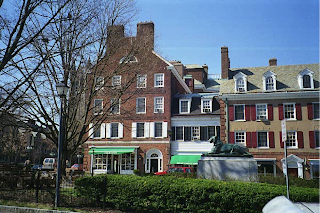From what I observed, Palmer Square in Princeton, New Jersey is used primarily as a place to walk through. It is most definitely aesthetically pleasing, and has a good walk way. Its surrounding buildings are also ones that are quite popular. If Jane Jacobs’ 4 characteristics were used to analyze Palmer Square, it would be done like so; there is not much intricacy, as there is a small variety of uses the park serves. There is a defined center which opens outward, and yet, pulls crowds inward. The sun shines through, which is nice in cool weather, and the trees serve as somewhat of a shade during the summer. The buildings surrounding and enclosing the park are prime ones which attract a variety of people, who use the park as a way to get to these buildings.
William Whyte brought up some key factors of a successful park or public space; “sittable space”, street, sun, food, water, trees, and triangulation. Whyte says “People tend to sit where there are places to sit”; he then elaborates on this and says how comfort does play a role. Palmer Square does offer some seating; none of which, however, is comfortable. The benches have no back rest, and the table and benches are made of a marble-like material which gets extremely cold in the winter. Whyte also emphasizes the importance of chairs, as they are portable. Palmer Square offers no chairs at all, which restricts people in terms of where they can sit. The street, though narrow and one way, is one of the park’s advantages, is the park is central, and is thus driven around a lot. There is plenty of sunlight, which people seem to love. There is a popular ice cream shop just steps away from the park, which is a great benefit, and there are several restaurants that are walking distance from the square. There are oodles of trees and greenery around the park, which is aesthetically pleasing to many.
The park, as stated before, is used mainly to walk through, as it is pleasant, beautiful, and peaceful. There are plenty of families, and students, as Princeton is a college town, but is also close to a suburb. The use of the park seems consistent, but does fluctuate with weather, and thus, probably seasons. The park is not unsuccessful, but most definitely has room for improvement. More lighting could be used at dark, and better seating is crucial. The town and park’s surroundings are certainly an advantage, and help give the park some of the success it has.





I wonder if Jane Jacobs' criteria have any relevance to Indian urban planning.
ReplyDelete